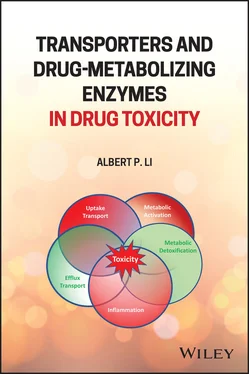1 ...8 9 10 12 13 14 ...28 More than 34 SNPs of CYP3A4 have been included in the PharmVar, but generally they do not translate to significant interindividual variability [41, 42]. The observed variability could not be explained by the SNP variations in the coding and 5′‐flanking regions of CYP3A4 [63]. Instead, the variations that affect CYP3A4 expression are more relevant to drug metabolism. The cis genetic variant CYP3A4*22 has a 15389C>T substitution in intron 6, which results in decreased hepatic CYP3A4 expression. It has been suggested that CYP3A4*22 might be of clinical relevance to statin therapy, as the plasma concentration of the statin drugs (e.g. simvastatin and lovastatin) largely is dependent on CYP3A4 activity [64]. In a small cohort study the patients carrying a CYP3A4*22 allele required a significantly lower dose to reach target levels of low‐density lipoprotein‐cholesterol [65]. Moreover, CYP3A4 expression is also affected by the trans genetic variations. Polymorphisms in CYP3A4 regulators, including FoxA2/A3 , HNF4a , PXR , and MDR1, have been suggested to explain ~24% of the interindividual variability in hepatic CYP3A4 expression [66]. Although CYP3A4 is the most abundant CYP in the liver and catalyzes the oxidation of a broad spectrum of drugs, little association has been established so far between CYP3A4 polymorphisms and DILI [6].
CYP3A5 expression is highly polymorphic. The most common loss‐of‐function variant is CYP3A5*3 , which harbors a 6986A>G mutation in the third intron [67]. This causes aberrant alternative splicing and a premature stop in protein translation. The resulting truncated protein is defective in enzymatic function. CYP3A5 genotype‐based dosing has been suggested for the immunosuppressant tacrolimus, used in patients who received kidney [68, 69]. The therapeutic index of tacrolimus is narrow, and adverse reactions such as nephrotoxicity, hypertension, and diabetes can occur at concentrations slightly above or within the therapeutic range [70]. Therefore, therapeutic drug monitoring and dose adjustment of tacrolimus are clinically important. CYP3A5*3 reportedly is associated with lower tacrolimus clearance, and poor metabolizer patients with CYP3A5*3 require lower doses to achieve target concentrations [71]. In a cohort study, 39% of the variability in the blood concentration‐to‐dose ratio of tacrolimus could be explained by CYP3A5*3 alone [72]. Whether CYP3A5 genotype‐based dosing is beneficial to kidney transplant recipients requires further investigation; however, it is considered an option in clinical practice.
The CYP2D6 polymorphism has been studied extensively, and 139 major variants have been cataloged in the PharmVar. The most common null allele in the Caucasian population is CYP2D6*4 , accounting for the majority (70–90%) of the poor metabolizer phenotype [41, 73]. CYP2D6*4 carriers all have a 1847G>A mutation, causing splicing defect and no protein expression in the liver. The CYP2D6*10 allele is most commonly found in Asians [74]. Double SNP mutations 100C>T (P34S) and 4181G>C (S486T) render the protein unstable. In the African population the CYP2D6*17 allele has the highest frequency [75]. Triple mutations, 1022C>T (T107I), 2851C>T (R296C), and 4181G>C (S486T), lead to a structural change in the active site, which alters the substrate specificity. The pharmacogenetic impact of CYP2D6 on opioid drugs has been demonstrated [76]. Tramadol, for example, is bioactivated by CYP2D6 into active metabolite O ‐desmethyltramadol [77]. Poor metabolizers are insensitive to opioids and have much lower analgesic response [78]. In contrast, ultrarapid metabolizers with duplicated CYP2D6 genes show significantly increased efficiency in converting opioid prodrugs such as tramadol and codeine into active metabolites, which could cause opioid overdose [79]. The impact of CYP2D6 polymorphism is not limited to opioid drugs but covers a spectrum of clinical drugs. It might be a contributing factor to the hepatoxicity of perhexiline and trazodone [80, 81]. The case of a CYP2D6 poor metabolizer with perhexiline‐associated DILI has been reported. Significantly higher plasma Cmax of m ‐chloro, 4‐phenylpiperazine, a hepatotoxic metabolite of trazodone, was observed in poor metabolizers in comparison to extensive metabolizers. However, the pharmacogenetic association has not been confirmed.
Genetic variation in CYP2C9 has been recognized as a host factor for adverse drug reactions because many of the CYP2C9 substrates have a narrow therapeutic index [41]. The most studied variants are CYP2C9*2 (3608C>T, R144C) and CYP2C9*3 (42614A>C, I359L), both of which have decreased enzyme activity. They are more prevalent in Caucasians than in Asians and Africans [82]. The most investigated case for CYP2C9 pharmacogenetics involves the vitamin K antagonist warfarin. Although warfarin contains both R ‐ and S ‐enantiomers, the S ‐enantiomer is three to five times more effective in anticoagulation than the R ‐enantiomer [83]. S ‐warfarin metabolism is highly dependent on CYP2C9. Both CYP2C9*2 and CYP2C9*3 carriers have decreased warfarin biotransformation and thus could be considered for dose adjustment, especially when genetic variation in VKORC1 (vitamin K epoxide reductase, complex I) is also present [84, 85]. CYP2C9 polymorphism also affects the metabolism of some NSAIDs, such as diclofenac and ibuprofen. A potential pharmacogenetic association of CYP2C9 with diclofenac hepatotoxicity was proposed [86], but was negated by pharmacokinetics studies [87, 88]. CYP2C9*2 has been reported to be associated with bosentan‐related DILI, as the metabolism of bosentan is substantially reduced in CYP2C9*2 carriers [49, 50]. CYP2C9*3 was implicated to hepatotoxicity of leflunomide in a single case [89].
The null allele of CYP2C19 is common, especially in Asians, with a frequency of 13–25% [41]. CYP2C19*2 and CYP2C19*3 are the two most important nonfunctional variants, which occur mainly in Caucasians and Asians, respectively [90]. CYP2C19*2 has a splicing defect while CYP2C19*3 has a premature stop codon. The bioactivation of the antiplatelet drug clopidogrel is dependent largely on CYP2C19 activity [23]. Poor metabolizer patients reportedly are associated with a decreased anticoagulant response and an increased risk of adverse cardiovascular events [91–93]. An isolated number of cases suggested a possible association of CYP2C19 variants with hepatotoxicity of Atrium (phenobarbital, febarbamate, and difebarbamate) [94] and troglitazone [95].
The most common variant is CYP2B6*6 , which harbors two SNP mutations (15631G>T and 18053A>G), causing two amino acid substitutions (Q172H and K262R). CYP2B6*6 is prevalent in different populations with variable frequency [96]. CYP2B6 has been suggested to have clinical implications in HIV therapy [97]. The antiretroviral medication efavirenz is metabolized by CYP2B6. Patients with CYP2B6*6 have decreased CYP2B6 activity and are associated with high plasma levels of efavirenz, which could increase the risk of central neuron system adverse events [92] and hepatic adverse events [48]. CYP2B6*1H and *1J are associated with ticlopidine hepatotoxicity in Japanese populations, possibly due to increased CYP2B6 expression [47].
Читать дальше












